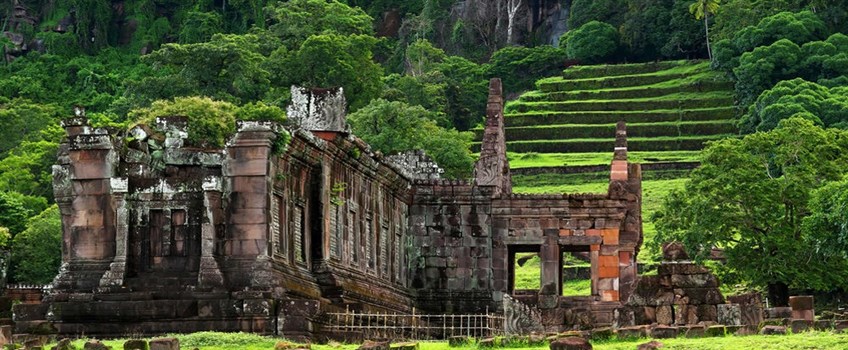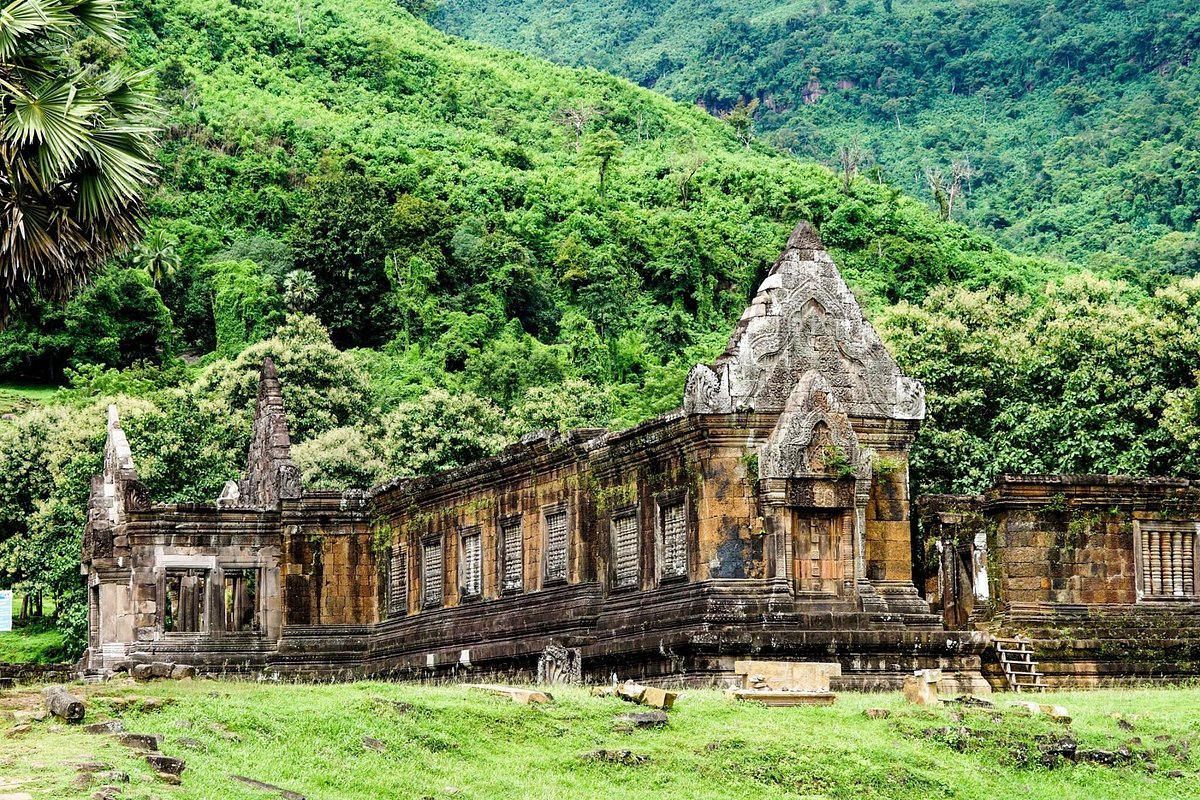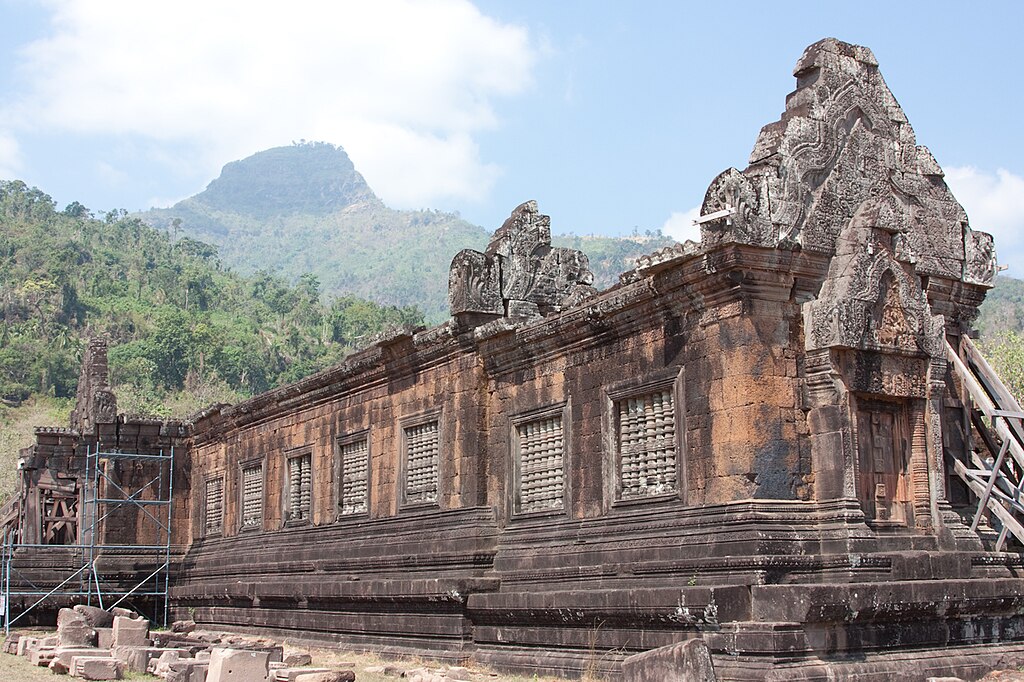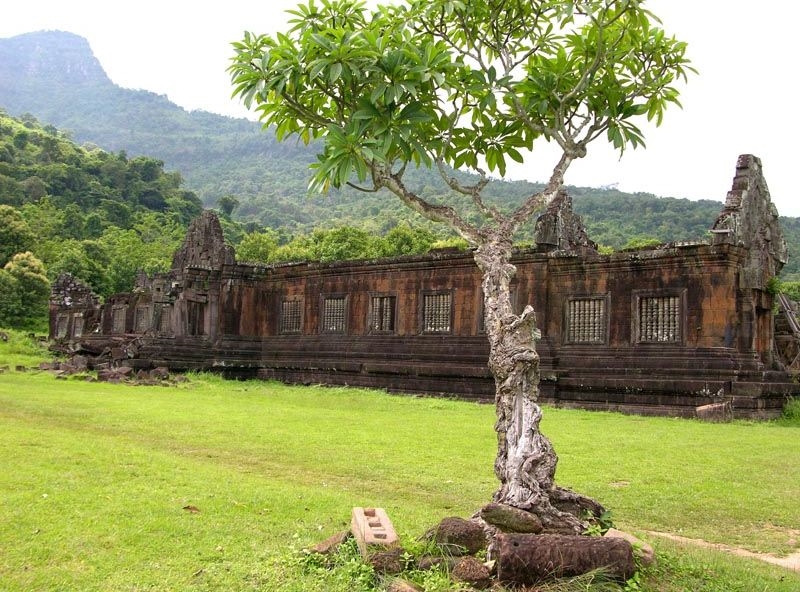Echoes of Shiva: Unveiling the Sacred Secrets of Wat Phu, Laos

Wat Phu, located in Champasak province, Laos, is a magnificent temple complex that dates back to the 5th century. It is one of the most important religious sites in the region and attracts visitors from all over the world. This blog post will give you an overview of Wat Phu and explain its significance in the Hindu-Buddhist culture.
Overview of Wat Phu, Laos
- Wat Phu, also known as Vat Phou, is a UNESCO World Heritage site with a series of temples and ancient ruins.
- The complex is situated on the slopes of Phu Kao mountain and offers breathtaking views of the surrounding countryside.
- The main temple at Wat Phu is dedicated to the Hindu god Shiva and is built in the Khmer architectural style.
- The temple complex also includes shrines, palaces, and other structures for various religious rituals and ceremonies.
- Visitors can explore the different parts of the complex, including the main temple, the courtyard, and the gallery, which houses ancient sculptures and artefacts.
Importance and significance of Wat Phu in the Hindu-Buddhist culture
- Wat Phu is considered a sacred site in both Hinduism and Buddhism. It is believed to be a place where the gods and ancestors reside.
- The temple complex is associated with the Khmer Empire, which had strong Hindu and Buddhist influences.
- Many Hindu deities, such as Shiva, Vishnu, and Brahma, are represented in the temple carvings.
- The complex also includes several Buddhist structures, reflecting the later influence of Buddhism in the region.
- Pilgrims and worshippers visit Wat Phu to pay their respects and seek blessings from the deities.
- The site is also popular for its annual festival, known as Boun Wat Phu Champasak, which attracts devotees from near and far.
Wat Phu is a significant religious site in Laos, with its rich history and architectural beauty. It holds great importance in Hinduism and Buddhism and is a place of worship and pilgrimage for many. A visit to Wat Phu offers a unique opportunity to explore the intersection of these two ancient cultures and appreciate the site's spiritual significance.

Historical Background
Origins of Wat Phu and its connection to the Khmer Empire
Wat Phu, located in Champasak province, Laos, is a magnificent temple complex that dates back to the 5th century. It is one of the most important religious sites in the region and attracts visitors from all over the world.
The temple complex is associated with the Khmer Empire, which had strong Hindu and Buddhist influences. The Khmer people, who ruled over the region then, built Wat Phu as a place of worship and spiritual significance.
Under the Khmer Empire, Wat Phu flourished and became a centre of religious and cultural activities. The temple complex was constructed in the Khmer architectural style and featured intricate carvings depicting Hindu deities such as Shiva, Vishnu, and Brahma.
Transformation of Wat Phu into a sacred site of worship
Over time, the religious significance of Wat Phu evolved, and it became a sacred site for both Hinduism and Buddhism. It is believed to be a place where the gods and ancestors reside.
As Buddhism gained prominence in the region, several Buddhist structures were added to the temple complex, reflecting the influence of both Hinduism and Buddhism in the area.
Today, Wat Phu continues to be a place of worship and pilgrimage for many. Pilgrims and worshippers visit the temple to pay their respects, seek blessings from the deities, and participate in religious ceremonies.
The annual festival, Boun Wat Phu Champasak, further showcases the cultural significance of Wat Phu, attracting devotees from near and far.
Wat Phu is a historical marvel and a symbol of the close connection between Hinduism and Buddhism. Its origins in the Khmer Empire and its continued importance as a sacred site highlight its significance in the region's religious and cultural traditions.
Architecture and Layout
Description of the main structures and temples within Wat Phu
When you visit Wat Phu, you will be amazed by the stunning architecture and layout of the temple complex. The main structures and temples within Wat Phu are:
- The Grand Staircase: This impressive staircase is the entrance to the temple complex. As you climb up the staircase, you will see beautiful stone carvings depicting mythological creatures and scenes from Hindu and Buddhist mythology.
- The Central Sanctuary: At the top of the staircase, you will find the Central Sanctuary, the main temple of Wat Phu. It is built in a pyramid shape and features intricate carvings of Hindu deities.
- The Naga Bridge: As you cross the Naga Bridge, you will notice the serpent-like Naga statues guarding the entrance to the temple. The Naga is a powerful mythical creature in Hindu and Buddhist mythology.
- The Buddha Footprint: This structure is a sacred footprint believed to belong to Lord Buddha. It is revered by Buddhists who visit Wat Phu as a symbol of enlightenment.
Symbolism and meaning behind the architectural elements of Wat Phu
The architectural elements of Wat Phu hold deep symbolism and meaning. Each structure and carving represents a significant aspect of Hinduism and Buddhism. Some of the symbolism found in Wat Phu includes:
| Architectural Element | Symbolism |
|---|---|
| Carvings of Hindu deities | Represents the fusion of Hinduism and Buddhism in the region. |
| The Naga Bridge | Symbolizes the bridge between the earthly realm and the spiritual realm. |
| The Central Sanctuary | Reflects the cosmic Mount Meru, the dwelling place of the gods in Hindu mythology. |
| The Buddha Footprint | Represents the enlightened path of Buddha and serves as a reminder of his teachings. |
Overall, the architecture and layout of Wat Phu offer a fascinating glimpse into the religious and cultural traditions of the region. The intricate carvings and symbolic elements make it a truly awe-inspiring experience for visitors.

Spiritual and Mythological Significance
Influence of Hindu and Buddhist beliefs in the spiritual practices at Wat Phu
When you visit Wat Phu, you will feel a profound spiritual presence influenced by Hindu and Buddhist beliefs. The fusion of these two religions is evident in the architectural elements and practices within the temple complex.
Buddhism is the prevailing religion in Laos, but Hinduism had a significant influence in the region centuries ago. Wat Phu represents the transition and coexistence of these two faiths in the area.
The presence of Hindu deities in the carvings at Wat Phu demonstrates the syncretism of Hindu and Buddhist beliefs. It showcases how these two religions have intertwined, creating a unique spiritual environment.
Legends and stories associated with the deities and ancient rituals at Wat Phu
Wat Phu is also rich in legends and stories associated with the deities worshipped in the temple. These myths and tales serve to deepen the spiritual significance of the site.
One famous legend is Lord Shiva descending to earth and making Wat Phu his home. As you explore the temple complex, you can imagine the ancient rituals performed to honour Lord Shiva and other deities.
Another story tells of the sacred footprint of Lord Buddha, symbolizing his enlightened path. This footprint evokes a sense of reverence and serves as a reminder of the teachings of Buddhism.
These legends and stories add a layer of mysticism to the spiritual experience at Wat Phu, allowing visitors to connect with the ancient traditions and beliefs of the region.
The spiritual and mythological significance of Wat Phu makes it a truly special and captivating place to visit. It offers a glimpse into the intertwined history of Hinduism and Buddhism and allows visitors to immerse themselves in the rich spiritual practices of the past.

Sacred Offering and Rituals
Explanation of the various rituals performed by worshippers at Wat Phu
When visiting Wat Phu, you will have the opportunity to witness and participate in various sacred rituals performed by worshippers. These rituals are deeply rooted in the spiritual beliefs of Hinduism and Buddhism, creating a unique and meaningful experience.
One of the common rituals is the lighting of incense and candles as an offering to the deities. This act symbolizes the purification of one's mind and the creation of positive energy. The fragrant smoke from the incense and the gentle flickering of the candles create a serene and peaceful atmosphere.
Another key ritual is making merit, known as "tam boon". Worshippers often offer the monks and the temple food, flowers, and other essential items. This act of generosity and kindness is believed to bring good luck and spiritual blessings.
Additionally, worshippers engage in meditative practices within the temple complex. They sit in quiet contemplation, seeking inner peace and spiritual connection. This practice allows individuals to focus their minds and deepen their connection with the divine.
Role of sacred offerings in honouring the deities and seeking blessings
The sacred offerings made by worshippers at Wat Phu play a crucial role in honouring the deities and seeking their blessings. These offerings are a physical manifestation of devotion and gratitude.
Food offerings, such as rice and fruits, are made to nourish and provide sustenance to the deities. These acts symbolize worshippers' care and respect for the divine beings they revere. It is believed that offering food can establish a harmonious relationship with the gods, inviting their divine presence and protection.
Flowers are also commonly offered at the temple as a symbolic gesture of beauty and impermanence. The delicate blossoms represent the transient nature of life and remind worshippers to appreciate the present moment.
Moreover, worshippers may offer small symbolic items like gold leaf, which signifies wealth and prosperity, or holy strings, believed to bring luck and protection. These offerings are a tangible expression of devotion and the desire for blessings and positive outcomes in life.
Overall, the sacred offerings and rituals at Wat Phu allow worshippers to deepen their spiritual connection, seek divine blessings, and express their reverence for the deities worshipped at the temple.

UNESCO World Heritage Status
Wat Phu's inclusion in the UNESCO World Heritage List
When you visit Wat Phu, you will be amazed that it has been granted the prestigious UNESCO World Heritage status. This recognition highlights the outstanding universal value of this ancient temple complex and its significance in human history and culture. The inclusion of Wat Phu in the UNESCO World Heritage List is a testament to its exceptional architectural and artistic features and its role in shaping Southeast Asia's religious and cultural landscape.
Preservation efforts and the significance of the recognition
The UNESCO World Heritage status brings immense pride to the local community and the nation of Laos. It acknowledges their commitment and efforts in preserving and protecting the historical treasure that is Wat Phu. The recognition also provides international visibility to the site, attracting tourists and researchers worldwide.
The preservation efforts at Wat Phu aim to safeguard its unique architecture, intricate carvings, and ancient structures from deterioration. With the support of the UNESCO World Heritage program, conservation projects have been implemented to ensure the long-term preservation of this valuable cultural heritage site.
The significance of being a UNESCO World Heritage site extends beyond preservation. It also signifies the place's outstanding value as a site of outstanding universal importance. Wat Phu represents an exceptional testimony to the blending of Hindu and Buddhist religious traditions, reflecting the historical and cultural exchange in the region.
The recognition enhances the understanding and appreciation of Wat Phu's cultural significance and promotes sustainable tourism development in the surrounding area. It encourages responsible tourism practices, ensuring visitors can admire and learn from this remarkable site while preserving its integrity for future generations.
Wat Phu's inclusion in the UNESCO World Heritage List is a testament to its remarkable historical and cultural significance. The recognition highlights the efforts to preserve this ancient temple complex and promotes awareness and appreciation of its unique value. When you visit Wat Phu, you witness a magnificent site and contribute to the sustainable preservation of this important heritage for generations to come.

Scenic Beauty and Surroundings
Description of the natural landscape and scenery surrounding Wat Phu
When you visit Wat Phu, you will be mesmerized by its historical and cultural significance and the breathtaking natural landscape surrounding it. The temple complex is at the base of a mountain, offering stunning panoramic views of the lush greenery and the winding Mekong River. As you explore the site, you will be immersed in a serene atmosphere, surrounded by the beauty of nature.
The natural landscape surrounding Wat Phu is characterized by rolling hills covered in dense forests, providing a picturesque backdrop to the ancient temple complex. The area is home to various species of flora and fauna, creating a harmonious ecosystem that adds to the site's tranquillity.
Exploring the Mekong River and its connection to Wat Phu
One of the most remarkable features of Wat Phu's surroundings is its proximity to the mighty Mekong River. The temple complex is located on the eastern bank of this iconic river, stretching thousands of kilometres through Southeast Asia. The Mekong River holds tremendous significance in the region, both culturally and environmentally.
Visitors to Wat Phu can explore the Mekong River by taking a boat ride or simply enjoying the scenic views from the temple complex. The river's waters reflect the golden rays of the sun, creating a magical ambience that complements the spiritual aura of Wat Phu.
Moreover, the Mekong River has played a crucial role in developing civilizations and trade routes in this part of the world. Its connection to Wat Phu further highlights the historical and cultural importance of the temple complex, as it served as a religious and cultural centre for communities residing along the river.
Wat Phu offers a glimpse into ancient history and culture, a breathtaking natural landscape, and a close connection to the iconic Mekong River. The temple complex's architectural beauty and surroundings make it a truly enchanting destination. When you visit Wat Phu, you will immerse yourself in a world of scenic beauty and tranquillity that will leave a lasting impression on your soul.

Visitor Information and Tips
Practical information for visiting Wat Phu, including entry fees and hours
- When planning your visit to Wat Phu, it's important to note that the temple complex is open daily from 8:00 am to 5:00 pm.
- The entrance fee for foreigners is 50,000 Lao Kip, equivalent to approximately $5.00 USD. This fee includes access to the entire site and the museum.
- It is recommended to allocate at least 2-3 hours for your visit to explore the temple complex fully and appreciate its beauty.
- If you're travelling with children or elderly family members, remember that some areas have steep stairs and uneven paths, so it's advisable to wear comfortable walking shoes and take necessary precautions.
- Bringing a hat, sunscreen, and mosquito repellent is also a good idea, as the weather can be quite hot and humid, especially during the summer months.
- For those who prefer guided tours, there are knowledgeable local guides available at the entrance who can provide more insights into the history and significance of Wat Phu.
Tips for experiencing the spiritual atmosphere and cultural aspects of Wat Phu
- Wat Phu is a historical site and an active Buddhist temple. It's important to respect and follow the cultural norms when exploring the complex.
- Dress modestly and appropriately, covering your shoulders and knees, as a sign of respect for the sacredness of the place.
- Follow local customs and remove your shoes before entering the main temple buildings.
- While exploring the site, try to maintain a peaceful and quiet demeanour to fully immerse yourself in the spiritual atmosphere and allow others to experience the tranquillity.
- Take the time to observe and appreciate the intricate stone carvings and architectural details that reflect the artistic prowess of the ancient Khmer Empire.
- Engage with the local monks or temple staff if you have any questions or want to learn more about Buddhism or the cultural traditions associated with Wat Phu.
- Finally, remember to take some moments for personal reflection and contemplation as you soak in the spiritual energy and connect with the centuries-old history of Wat Phu.

Personal reflections and recommendations for visiting Wat Phu
Visiting Wat Phu is a memorable experience combining history, spirituality, and natural beauty. Here are some personal reflections and recommendations based on my visit:
- Allow yourself ample time to explore and appreciate the temple complex. Spend a peaceful moment in each area, allowing the energy of the place to unfold.
- Take advantage of the guided tours available at the entrance. The local guides provide fascinating insights into the history and significance of Wat Phu, enriching your overall experience.
- Don't rush through the site. Take the time to sit and meditate, letting the serenity of Wat Phu seep into your soul.
- Witness the sunset or sunrise from one of the viewpoints near the temple. The aura of tranquillity during these moments is truly enchanting.
- Capture the beauty of Wat Phu through photography, but remember to put your camera aside now and then and fully immerse yourself in the present moment.
- Support the local community by purchasing traditional handicrafts or souvenirs from local artisans.
- Finally, be respectful of the surroundings and fellow visitors. Remember, Wat Phu holds immense cultural and spiritual value for the local people, and we should honour that as visitors.
Visiting Wat Phu is an opportunity to step back in time and connect with Laos's rich history and spirituality. By following the practical tips and embracing the cultural aspects, your experience at Wat Phu will undoubtedly leave a lasting impression.
